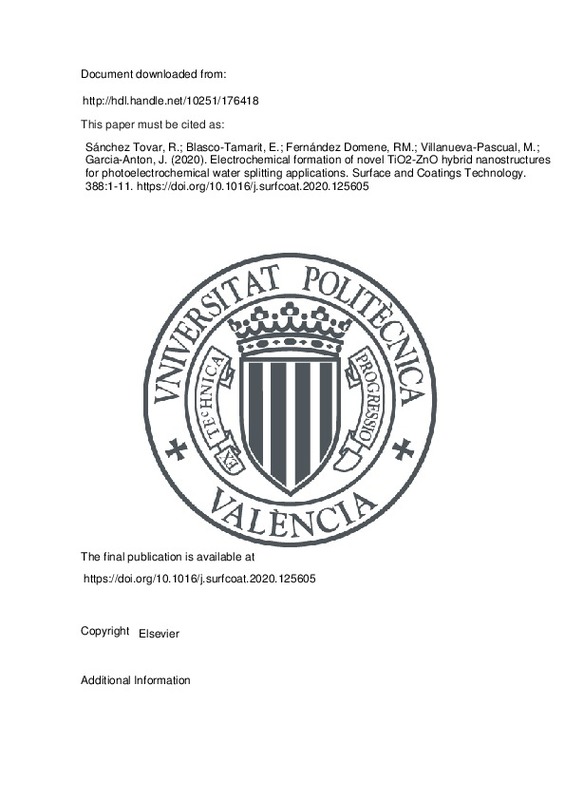JavaScript is disabled for your browser. Some features of this site may not work without it.
Buscar en RiuNet
Listar
Mi cuenta
Estadísticas
Ayuda RiuNet
Admin. UPV
Electrochemical formation of novel TiO2-ZnO hybrid nanostructures for photoelectrochemical water splitting applications
Mostrar el registro sencillo del ítem
Ficheros en el ítem
| dc.contributor.author | Sánchez Tovar, Rita
|
es_ES |
| dc.contributor.author | Blasco-Tamarit, E.
|
es_ES |
| dc.contributor.author | Fernández Domene, Ramón Manuel
|
es_ES |
| dc.contributor.author | Villanueva-Pascual, M.
|
es_ES |
| dc.contributor.author | Garcia-Anton, Jose
|
es_ES |
| dc.date.accessioned | 2021-11-05T14:10:30Z | |
| dc.date.available | 2021-11-05T14:10:30Z | |
| dc.date.issued | 2020-04-25 | es_ES |
| dc.identifier.issn | 0257-8972 | es_ES |
| dc.identifier.uri | http://hdl.handle.net/10251/176418 | |
| dc.description.abstract | [EN] In this study, hybrid ZnO-TiO2 nanostructures have been synthesised by means of a simple electrochemical anodisation of titanium and subsequently ZnO electrodeposition. The influence of Zn(NO3)(2) concentration and temperature during the electrodeposition process was evaluated. Different techniques were used to analyse the synthesised nanostructures, notably Field Emission Scanning Electron Microscopy (FE-SEM) with Energy-dispersive X-ray spectroscopy (EDX) and Confocal Microscopy with Raman spectroscopy coupled with an Atomic Force Microscope. Photoelectrochemical water splitting tests were also performed at the hybrid nanostructures. According to the results, the photoelectrochemical response of the specimens increases with the addition of ZnO, besides the hybrid nanostructures obtained at 25 degrees C and using a Zn(NO3)(2) concentration of 1 mM showed photocurrent densities 80% higher than the ones obtained for TiO2 nanotubes. Analysis of Variance of the data confirms the obtained results. | es_ES |
| dc.description.sponsorship | Authors thank for the financial support to the Ministerio de Economía y Competitividad (Project Code: CTQ2016-79203-R), for its help in the Laser Raman Microscope acquisition (UPOV08-3E-012) and for the co-finance by the European Social Fund. Authors also thank the Generalitat Valenciana for its financial support through the project: IDIFEDER/018/044 co-finance by the European Social Fund. Authors also thank to the UPV for the concession of a post-doctoral grant (PAID-10-17) to Ramón M. Fernández Domene. | es_ES |
| dc.language | Inglés | es_ES |
| dc.publisher | Elsevier | es_ES |
| dc.relation.ispartof | Surface and Coatings Technology | es_ES |
| dc.rights | Reconocimiento - No comercial - Sin obra derivada (by-nc-nd) | es_ES |
| dc.subject | Hybrid nanostructures | es_ES |
| dc.subject | Titanium dioxide | es_ES |
| dc.subject | Zinc oxide | es_ES |
| dc.subject | Photoelectrochemical water splitting | es_ES |
| dc.subject.classification | INGENIERIA QUIMICA | es_ES |
| dc.title | Electrochemical formation of novel TiO2-ZnO hybrid nanostructures for photoelectrochemical water splitting applications | es_ES |
| dc.type | Artículo | es_ES |
| dc.identifier.doi | 10.1016/j.surfcoat.2020.125605 | es_ES |
| dc.relation.projectID | info:eu-repo/grantAgreement/MINECO//UPOV08-3E-012/ | es_ES |
| dc.relation.projectID | info:eu-repo/grantAgreement/UPV//PAID-10-17/ | es_ES |
| dc.relation.projectID | info:eu-repo/grantAgreement/GVA//IDIFEDER%2F2018%2F044//MODIFICACIÓN DE FOTOCATALIZADORES DE ÓXIDOS METÁLICOS NANOESTRUCTURADOS PARA LA ELIMINACIÓN DE FÁRMACOS Y PRODUCCIÓN ENERGÉTICA/ | es_ES |
| dc.relation.projectID | info:eu-repo/grantAgreement/AEI//CTQ2016-79203-R//MODIFICACION DE FOTOCATALIZADORES DE OXIDOS METALICOS NANOESTRUCTURADOS PARA LA ELIMINACION DE FARMACOS Y PRODUCCION ENERGETICA/ | es_ES |
| dc.rights.accessRights | Abierto | es_ES |
| dc.contributor.affiliation | Universitat Politècnica de València. Departamento de Ingeniería Química y Nuclear - Departament d'Enginyeria Química i Nuclear | es_ES |
| dc.description.bibliographicCitation | Sánchez Tovar, R.; Blasco-Tamarit, E.; Fernández Domene, RM.; Villanueva-Pascual, M.; Garcia-Anton, J. (2020). Electrochemical formation of novel TiO2-ZnO hybrid nanostructures for photoelectrochemical water splitting applications. Surface and Coatings Technology. 388:1-11. https://doi.org/10.1016/j.surfcoat.2020.125605 | es_ES |
| dc.description.accrualMethod | S | es_ES |
| dc.relation.publisherversion | https://doi.org/10.1016/j.surfcoat.2020.125605 | es_ES |
| dc.description.upvformatpinicio | 1 | es_ES |
| dc.description.upvformatpfin | 11 | es_ES |
| dc.type.version | info:eu-repo/semantics/publishedVersion | es_ES |
| dc.description.volume | 388 | es_ES |
| dc.relation.pasarela | S\422225 | es_ES |
| dc.contributor.funder | Generalitat Valenciana | es_ES |
| dc.contributor.funder | AGENCIA ESTATAL DE INVESTIGACION | es_ES |
| dc.contributor.funder | Universitat Politècnica de València | es_ES |
| dc.contributor.funder | Ministerio de Economía y Competitividad | es_ES |







![[Cerrado]](/themes/UPV/images/candado.png)

